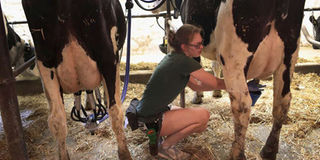Your Animal Doctor

A part-time employee milks cattle in a dairy farm. Before milking a cow, use a strip cup to check if any of the animal's udder's quarters are infected with clinical mastitis. FILE PHOTO | NMG
What you need to know:
- The biggest cost is loss of production given that once the udder is infected, the cow is not able to get back to its original production levels.
- Ensure your milking jelly has its cap always replaced after use as this can be a source of infection. Milk the cow and after finishing, apply a post milking teat dip.
- Diarrhoea in goat kids is also known as scouring. It is one of two main causes of mortalities and other young animals, the other being pneumonia.
- To hasten rumen development, you should introduce your calves to Intromilk calf milk replacer immediately after colostrum.
Traces of blood in cow’s milk
I have noticed some traces of blood in my cow’s milk. I have used tubes but the problem is not going away. What can I use?
Moses
Your cow has clinical mastitis, a visible infection of the mammary glands. Mastitis is a management disease that is very costly to the farmer.
The biggest cost is loss of production given that once the udder is infected, the cow is not able to get back to its original production levels.
The fact that the disease keeps recurring points to challenges in your management particularly of the milking process.
Mastitis causing agents enter the mammary glands through the teat opening and move up the canal to multiply in the udder tissue.
Milk in the udder provides a conducive environment for the multiplication of the bacteria.
For a start, ensure that your cow’s environment is cleaned and disinfected regularly as are all your milking equipment.
As you prepare to milk, wash your hands with water and soap and disinfect, wash the cow’s udder with warm water and then dry with a disposable clean paper towel.
Before milking, use a strip cup to check if any of the quarters are infected. You may also use a CMT kit. Infected quarters must be milked last.
Ensure your milking jelly has its cap always replaced after use as this can be a source of infection. Milk the cow and after finishing, apply a post milking teat dip.
If more than one cow is being milked, ensure a cow with sick quarter(s) is milked last. Provide dairy meal to your cow after milking to ensure she remains standing until the teat canal closes.
Note that the teat canal remains open for about 30 minutes after milking and a cow lying down in an unclean floor would have disease agents enter the teat opening.
In your case, get a qualified vet to check on your cow, collect milk samples for the lab to do culture and sensitivity test.
The lab will then advise you on the drugs that the disease agents are sensitive to. Ensure you use the drugs according to the manufacturer’s instructions.
Your vet will also determine whether systemic treatment (injections) is necessary.
****
Diarrhoea in goats
My goat calved twins but both have persistent diarrhoea. What can I give them?
Muthoni
Diarrhoea in goat kids is also known as scouring. It is one of two main causes of mortalities and other young animals, the other being pneumonia.
Scouring may be caused by infectious agents finding their way into the kids through milk and at times by feeding too much milk at once.
If left untreated, the kids become dehydrated leading to organ damage and death. Call a qualified veterinarian to administer appropriate antibiotics and supportive therapies such as Electrosol Oral through their drinking water.
Electrosol Oral is a well-balanced combination of dextrose for energy and electrolytes to replace those lost through the diarrhoea.
****
Time to wean and deworm calves
When should I wean my calves and what is the right time to deworm?
Peter
The calf may be weaned at 12 weeks of age when the rumen is sufficiently developed to start digesting grass.
To hasten rumen development, you should introduce your calves to Intromilk calf milk replacer immediately after colostrum.
This replacer is rich in proteins, fats, minerals and fibre and is highly digestible. Weaning should be done by gradually reducing the amount of Intromilk given and providing the calves with good quality fodder/hay and concentrates.
You may supplement the calves with Stimosol Oral, which is a balance of yeast, vitamins, organic acids and minerals that increase feed intake, improve digestibility, and ultimately boosts growth and performance.
Deworm the calves after two months, thereafter every three months or so.
****
Dr John Muchibi is a Veterinary Surgeon and the Animal Health Manager at Elgon Kenya Ltd. Reach him through +254733715102 or e-mail him through [email protected]





